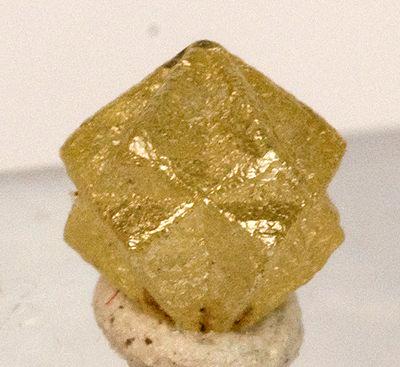 |
| Interpenetrating cubes of diamond Photo by Rob Lavinsky |
The word morphology means what it
looks like. Diamond crystals are a good
example of this as in the growth process they are able to take on many
guises. They all however are caused by
the basic shape of the carbon cell that controls the diamond growth. The carbon cell is used to build the diamond
crystal or stated in another way a diamond molecule. These carbon cells are deposited onto the
nucleus of the diamond one layer at a time until the diamond finishes
growing. In its purest form a diamond
crystal is cubic like a crystal of sugar.
The addition of various elements however causes a diamond to morph into
different shapes or colors.
The most common of these shapes are the cubic form that is square
like a salt crystal or the octahedron which is two pyramids stuck together base
to base. From this simple crystal form
the shape of a diamond becomes more complex. This is caused by many different physical
process; the most common being the physical space allotted to the diamond
crystal to grow. If this allotted space
is cramped and not shaped like a typical space the diamond crystal will grow
into the shape of the space. Something that will further complicate the
final shape of the diamond crystal that is delivered to the surface of the
Earth is the dissolution of the diamond in carbonate or silicate bearing water
at the pressure-temperature conditions encountered in the diamond stability
field. This was established
experimentally by Alexander
F. Khokhryakov and Yuri N. Pal.Yanov of the Siberian Branch of the Russian Academy Novosibirsk Russia
 |
| The macle another form of diamond crystal Photo by Rob Lavinsky |
One of
the stranger forms of diamond growth is exemplified by the rough diamonds from
the Ekati, Diavik and Snap Lake Canada Canada
There
are one or more generations of crystal growth in most diamond crystals. A diamond crystal can also undergo retrograde
growth where conditions either in the area in the mantle where it was formed or
on its way to the surface in kimberlite magma. Some of these crystals can become bizarre in
their appearance, and some of the more bizarre are what are called skeletal
crystals. Sometimes the diamonds are
etched into more rounded shapes by the action of the chemistry of where they
are formed or transported.
The
macle is another shape the diamond can naturally take this is a twinned diamond
taking a triangular shape and has two large triangular sides.
References:
nice post!!loved it
ReplyDeleteif anyone wants to know more related to related to online jewellery then check our website>>
gemstones| blue sapphire
Amethysts are the incredible issue solvers of the precious stone world. As a result of their capacity to enable you to slice through troublesome circumstances and comprehend what you are truly finding before you, they make it conceivable to get past troublesome decisions and basic leadership forms as effortlessly as could reasonably be expected.Buy Amethysts online
ReplyDelete
ReplyDeleteFantastic blog! Do you have any tips and hints for aspiring writers? I’m planning to start my own website soon but I’m a little lost on everything.
Get Benefits of Amethyst Gemstone.
This comment has been removed by the author.
ReplyDelete